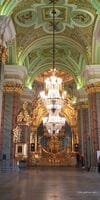The Peter and Paul Cathedral and the Grand Ducal Tomb are monumental structures located on the main square of the Peter and Paul Fortress (Hare Island) in St. Petersburg.
The Peter and Paul Cathedral and the Grand Ducal Tomb, although they are separate structures (buildings) erected in different eras, are almost always considered in a complex.
This happens for the following reasons:
- they are located next to each other and are connected by a covered gallery (corridor), to which the former royal waiting rooms are adjacent;
- they are a single architectural complex, which is an architectural monument;
- the cathedral and the tomb were used as the tombs of Russian emperors and uncrowned members of the imperial House of Romanov;
- today, to visit the cathedral and the tomb, you need to purchase a single ticket.
The Peter and Paul Cathedral and the Grand Ducal Tomb are a single ideological and compositional core of the ensemble of the Peter and Paul Fortress.
Peter and Paul Cathedral
Peter and Paul Cathedral-the full official name is the Cathedral in the name of the First Apostles Peter and Paul.
The history of the cathedral dates back to the beginning of the 18th century, when on June 29 (July 10, new style), 1703, at the initiative of Peter I, a wooden church was laid.
Since the church was founded on the day of the Holy Apostles Peter and Paul, its consecration on April 1 (12), 1704 was held in honor of these saints.
The stone Peter and Paul Cathedral was laid on May 30 (June 10), 1712 on the site of a wooden church. The construction of the cathedral was completed in 1733. The cathedral was built according to the project and under the direction of the Swiss architect DomenicoTresini.
The consecration of the stone cathedral took place on July 29, 1733 - the feast of the Holy Apostles Peter and Paul.
From 1742 to 1858 (before consecration St. Isaac's Cathedral) The Peter and Paul Cathedral was a cathedral, then it was transferred to the court department.
During the history of the cathedral was restored and improved.
During the Great Patriotic War, the Peter and Paul Cathedral was severely damaged. After it was restored.
Today, the Peter and Paul Cathedral is a monument of architecture of the early Russian (or so-called Peter's) Baroque style.
Externally, the cathedral is an elongated rectangular structure to the east-a basilica of the " zal " type. This type of cathedral was not typical of the Russian architecture of those times - the cathedral corresponded to Western European architecture.
The main decoration of the cathedral is its multi-tiered high tower-bell tower. The top of the tower is decorated with a long gilded spire, which is crowned by a weather vane-the figure of the guardian angel (archangel), which is one of the symbols of St. Petersburg.
The angel on the spire of the cathedral appeared in the 1720s at the suggestion of Trezzini. The angel is placed on the ball that crowns the spire of the cathedral, and above the figure of the angel is a cross.
The spire of the cathedral has a height of 122.5 meters. From 1733 to 2012, the cathedral, thanks to its bell tower with a spire, was the tallest building in St. Petersburg, and until 1952-the tallest in Russia.
The tower with the spire is clearly visible from afar.
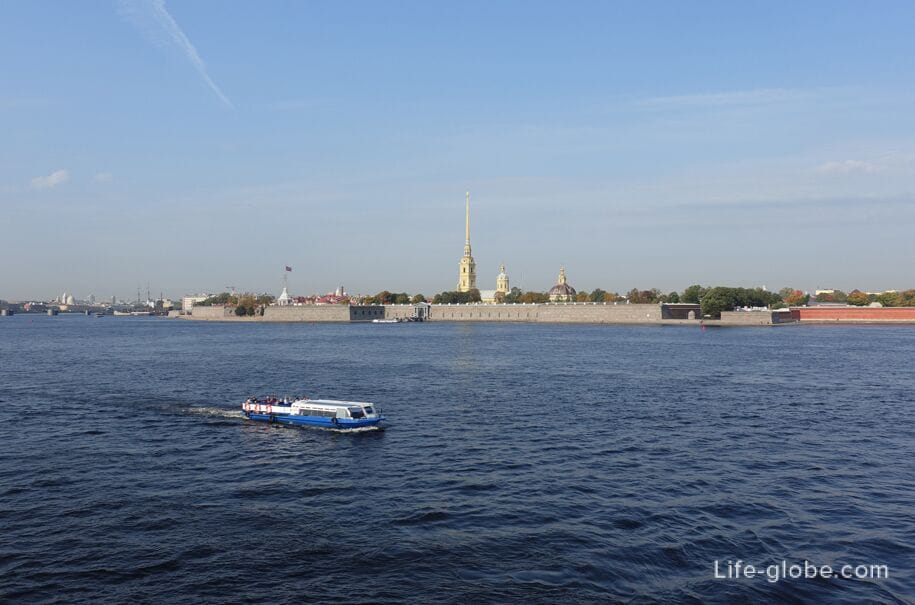
View from Trinity Bridge to the Peter and Paul Fortress, the spire of the Peter and Paul Cathedral and the dome of the Grand Ducal Tomb
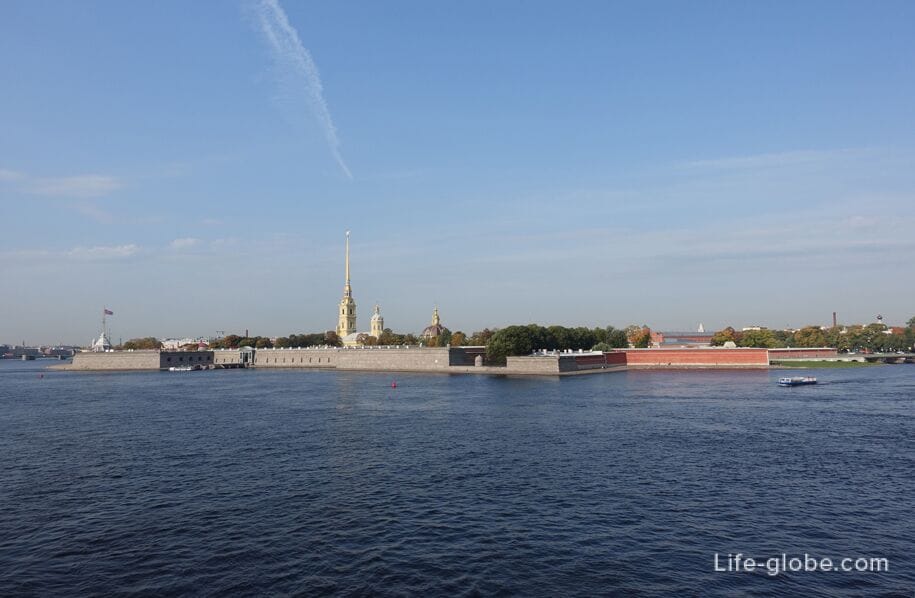
On the spire of the cathedral there is a clock-chimes, first installed in the 18th century.
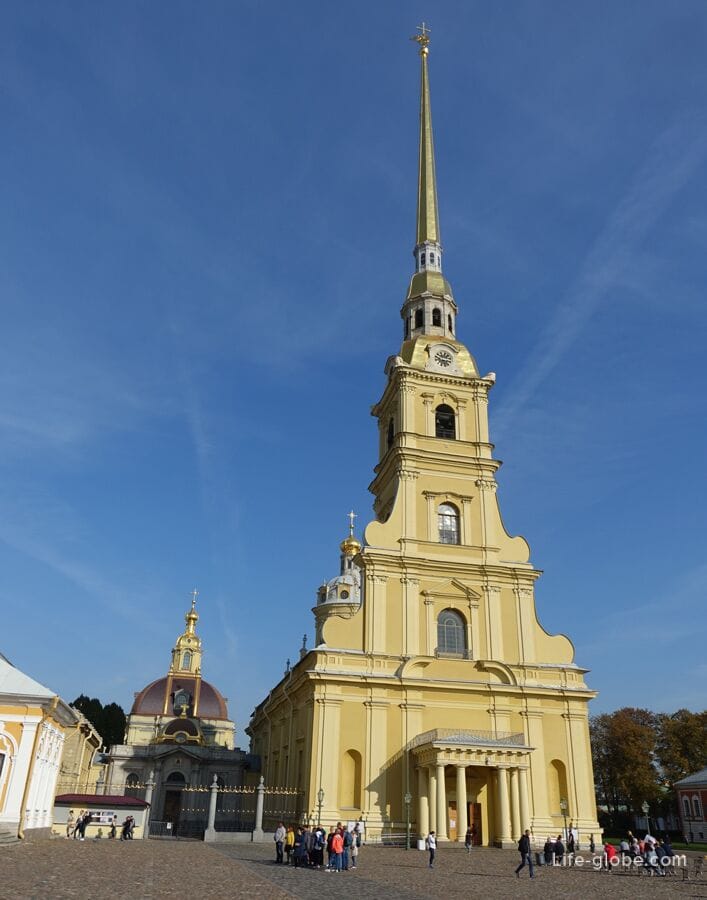
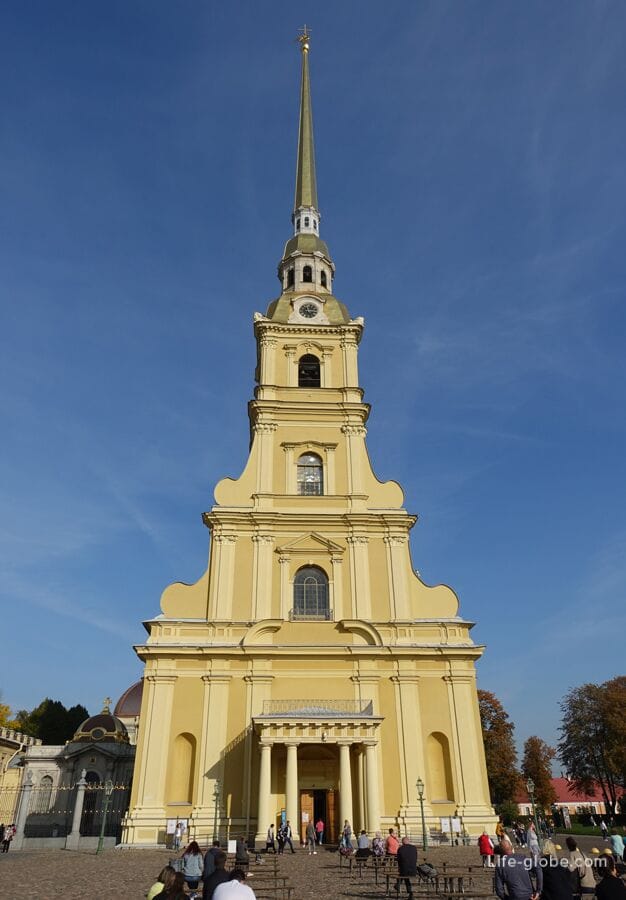
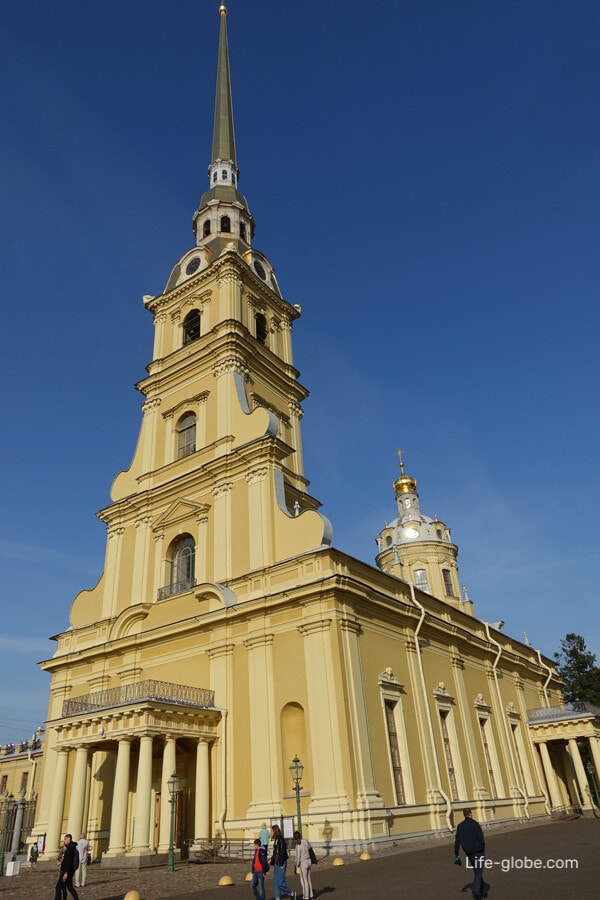

Inside the Peter and Paul Cathedral
Russian Russian soldiers have kept the captured banners and the keys to the cities and fortresses captured by the Russian troops in the Peter and Paul Cathedral for two centuries, which was a monument to the glory of Russian weapons. At the beginning of the 20th century, these relics were transferred to The Hermitage. Copies of Swedish and Turkish banners are now displayed in the cathedral.
In 1919, divine services in the Peter and Paul Cathedral ceased. In 1922, the cathedral was made a museum, and in 1954 - transferred to the State Museum of the History of Leningrad (St. Petersburg).
Today, the cathedral functions as a museum, and it also holds memorial services for Russian emperors.
The funeral services for the emperors are held in the cathedral, since the cathedral was also the tomb of crowned heads (Russian emperors).
The history of the cathedral as the tomb of the reigning House of Romanov dates back to the time of the first wooden church standing on the site of the present Peter and Paul Cathedral. In 1708, the daughter of Peter I, Catherine, was buried in the cathedral. Later, almost all Russian emperors and empresses, as well as many members of the imperial family, with the exception of Peter II and John VI, were laid to rest in the cathedral.
Peter II died in Moscow and was buried in the Archangel Cathedral. The burial place of John VI is still not exactly known.
On July 17, 1998, the burial of the remains belonging, according to the conclusion of a special government commission, to the last Russian Emperor Nicholas II, members of his family, servants and a life doctor, who were shot by the Bolsheviks in Yekaterinburg in July 1918, took place in the Catherine's Limit of the Peter and Paul Cathedral.
On September 28, 2006, the reburial of the remains of Empress Maria Feodorovna, the wife of Alexander III, brought from Denmark, took place in the Peter and Paul Cathedral.
In total, the remains of 50 people are currently buried in the cathedral, 46 of them are representatives of the Romanov dynasty.
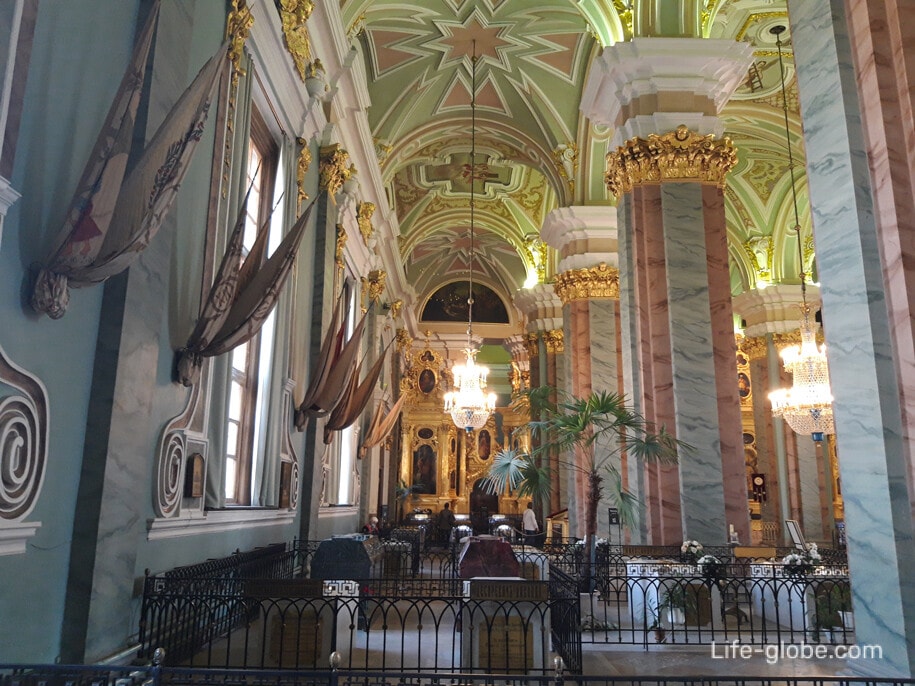
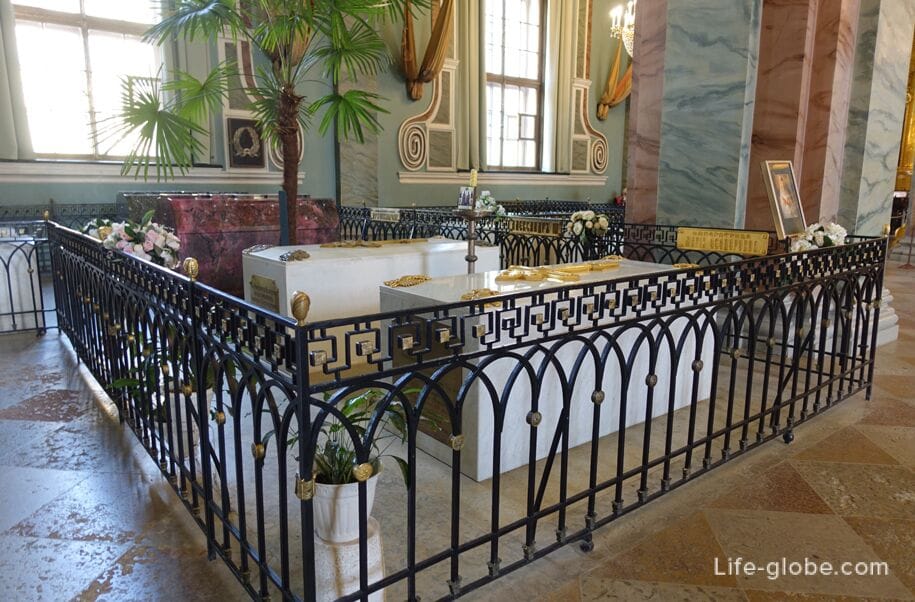
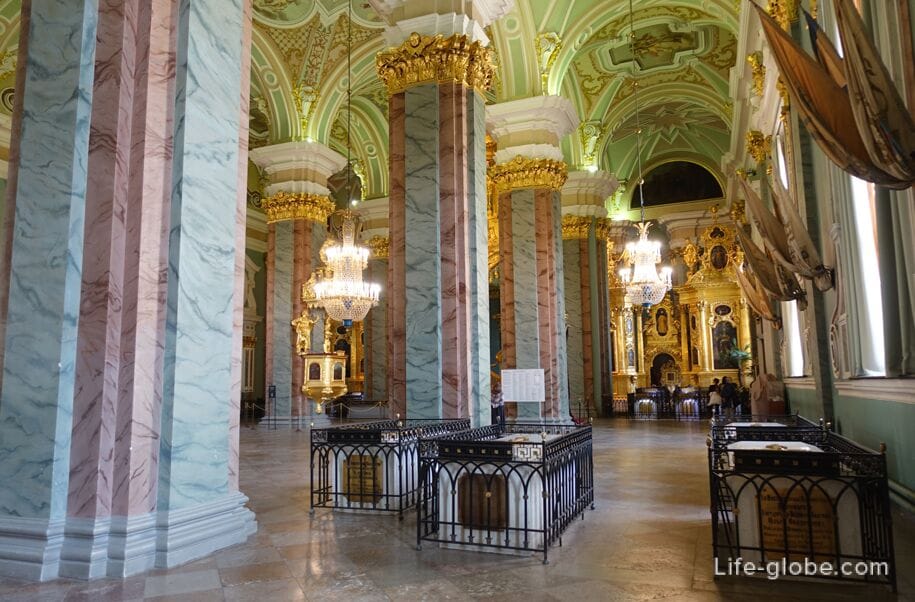
The Cathedral of the Holy Great Martyr Catherine was built in the Peter and Paul Cathedral in the late 18th century, when during the restoration of the cathedral after the fire of 1756, an additional wall was erected inside the church hall, separating a small space in its western part.
As a result, two new rooms were formed to the right and left of the main entrance to the cathedral, which were also used for burial.
In the right one, an iconostasis and a throne were installed, and on November 24, 1779, an altar was consecrated in honor of the patron saint of the Empress Catherine II.
In this limit, in addition to the remains of Nicholas II, his family and servants, there is also the tomb of Queen Marfa Matveevna-the wife of Peter I's older brother, Tsar Fyodor Alekseevich, who was buried on January 7, 1716.
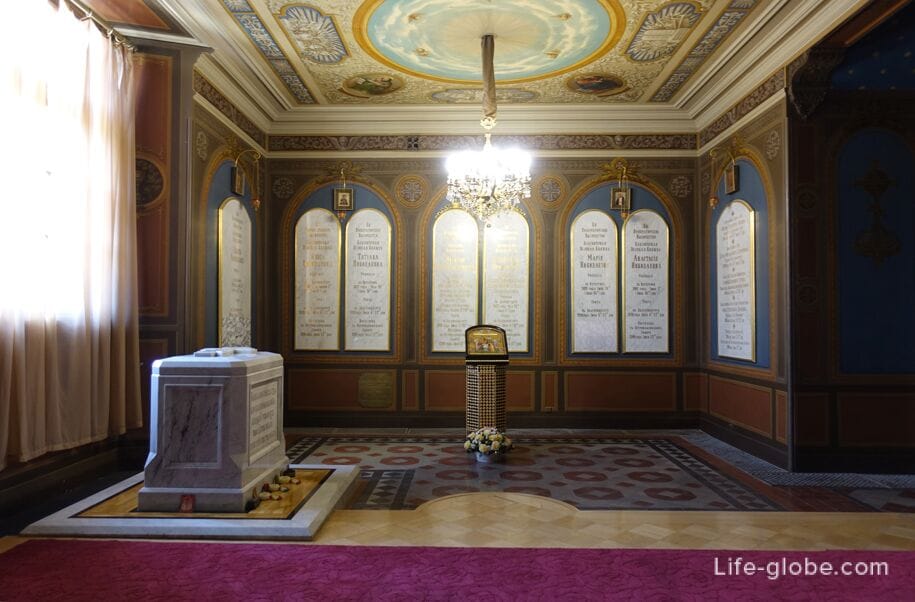
The grave of Marfa Matveevna

Also in the Catherine's Limit, officials of the Mint were previously sworn in, during Lent, soldiers and officers of the garrison of the Peter and Paul Fortress and their family members confessed and received communion. In several cases, the funeral service was held for the deceased minor grand ducal children.
In the left limit, the entrance to which is located immediately to the left of the main entrance to the cathedral, there are the graves of Tsarevna and Grand Duchess Maria Alexandrovna, Tsarevich and Grand Duke Alexei Petrovich and Crown Princess Charlotte-Christana-Sofia, born in Blankenburg.
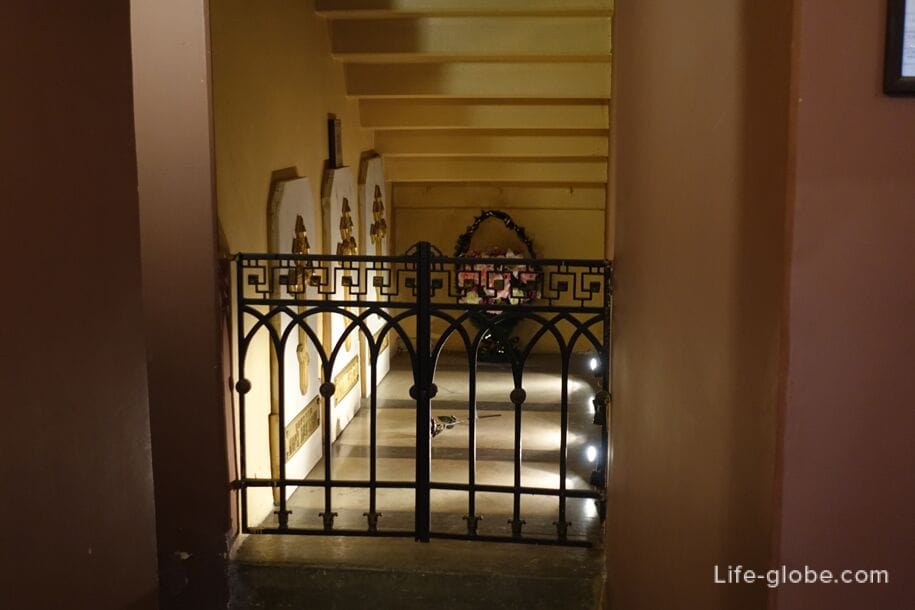
Other burials in the cathedral include:
- the tombs of Emperor Alexander II and his wife, Empress Maria Alexandrovna.
Alexander II died on March 1 (13 in the new style), 1881, as a result of an attempt (explosions of two bombs), which occurred on the embankment of the Griboyedov Canal in St. Petersburg.
At the site of the assassination attempt, there is now a temple erected as a memorial monument to the emperor - Saviour on the Blood (Church of the Resurrection of Christ).
The sarcophagi of the emperor and Empress in the Peter and Paul Cathedral are made of valuable rocks-Revnevskaya jasper (green) - the sarcophagus of Emperor Alexander II, from rodinite (pink) - the sarcophagus of Maria Alexandrovna.
The kiots in the cathedral "Spas on Blood" are made of the same rocks»;


- burials of the 18th century, located in the south-eastern part of the Peter and Paul Cathedral (near the iconostasis). In this part of the cathedral is buried Pert I, and the closest of Peter, so to speak, the beau monde of the first Emperor of All Russia: Catherine I, Anna I Ioannovna, Elizabeth Petrovna, Peter III and Catherine II.

Near the tomb of Peter I, on the fence, there is a bronze bust of him. Near the wall there is a marble Pieta (Mourning for Christ), and on the wall there is a wreath made of brass, made in memory of the 300th anniversary of the founding of the Arsenal plant by Peter I.
The tomb itself is decorated with medals. The tradition of placing medals on the tomb of Peter I dates back to 1803, when a gold medal was placed there on the instructions of Alexander I, presented to the emperor by a deputation of Petersburgers on the occasion of the 100th anniversary of the city.
Later, on the grave of the founder of the city, more medals appeared, stamped for various anniversaries;
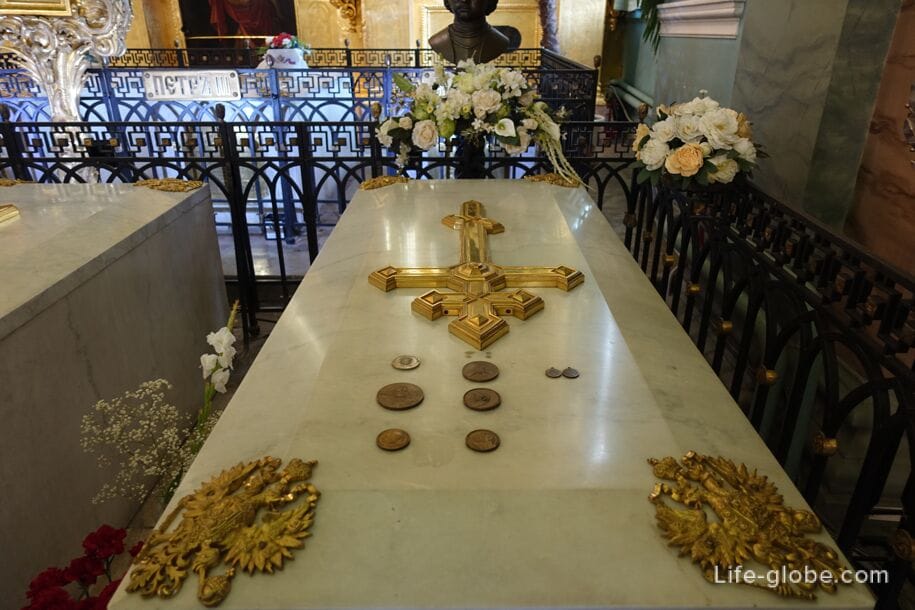
- in the south-eastern part of the Peter and Paul Cathedral (near the iconostasis), there are 7 graves of Emperor Paul I and his close family members;

- near the northern exit is the tomb of the children of Peter I, who died in infancy.
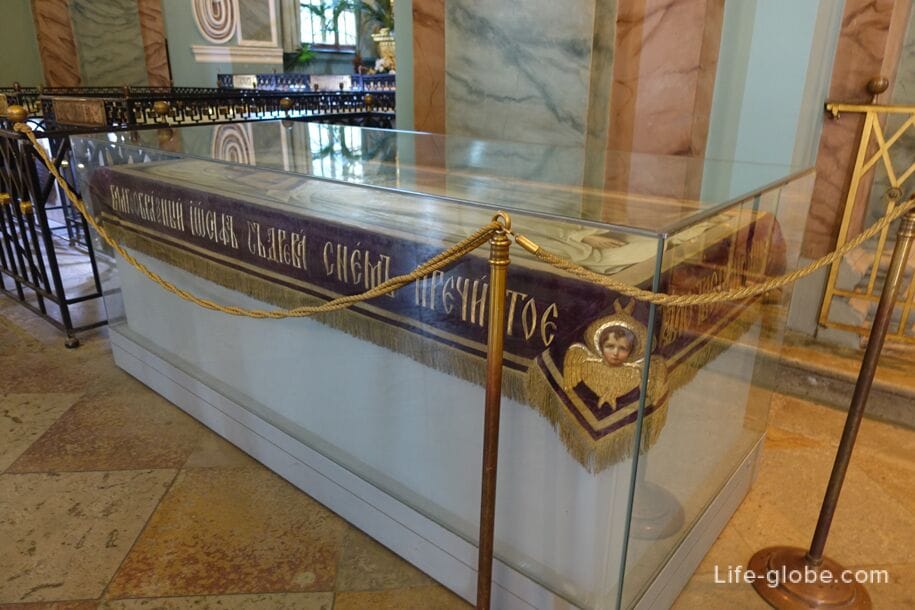
The interior of the Peter and Paul Cathedral is harmonious in a combination of colors and elegantly decorated in an eclectic style.
The interior of the cathedral is divided into three naves by massive columns with arched ceilings.
The walls, lined with Serdobolsky granite and white Italian marble, create a contrast against the background of dark Labrador columns.
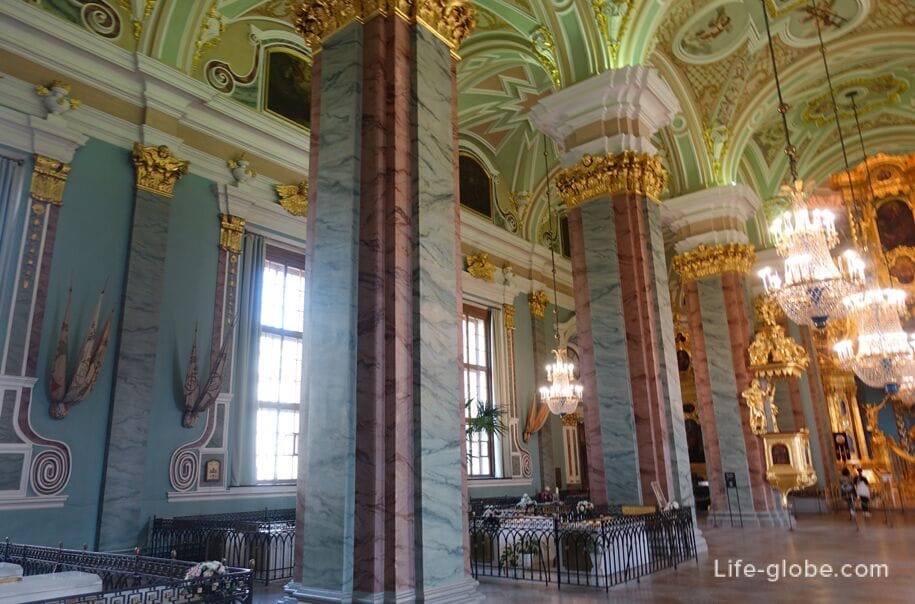
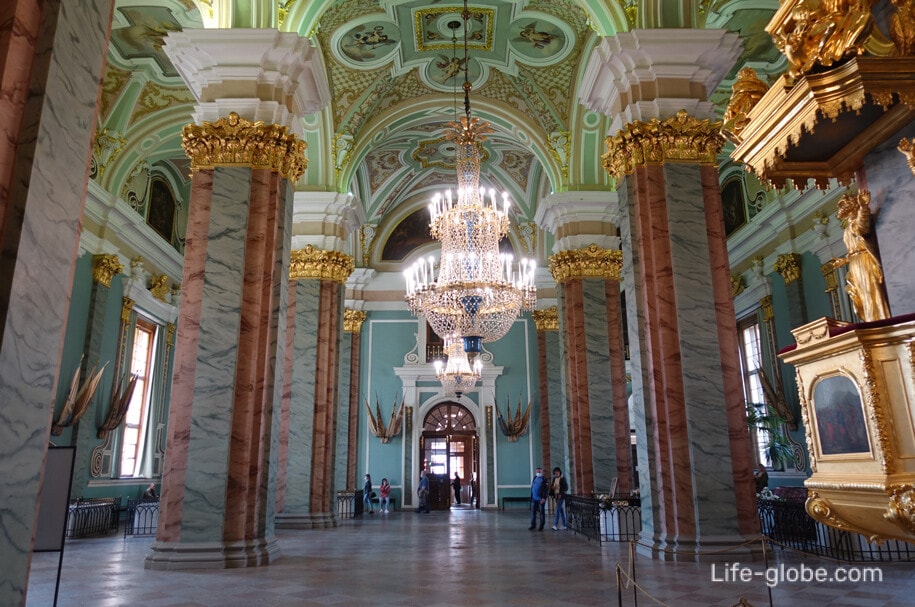
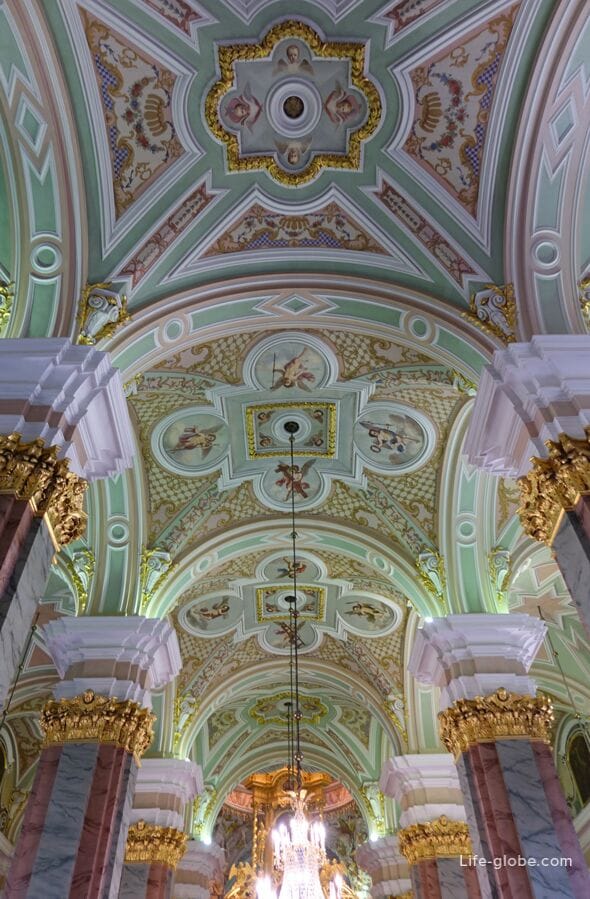
The gilded carved iconostasis was executed in 1722-1726 in Moscow under the direction of I. P. Zarudny.
The program of the iconostasis was made by Peter I himself and Archbishop of Novgorod Feofan Prokopovich. The composition of the iconostasis includes five large kiosks. They contain 43 icons painted in 1726-1729 by the Russian icon painters A. Pospelov and F. A. Pospelov. Protopopovym.
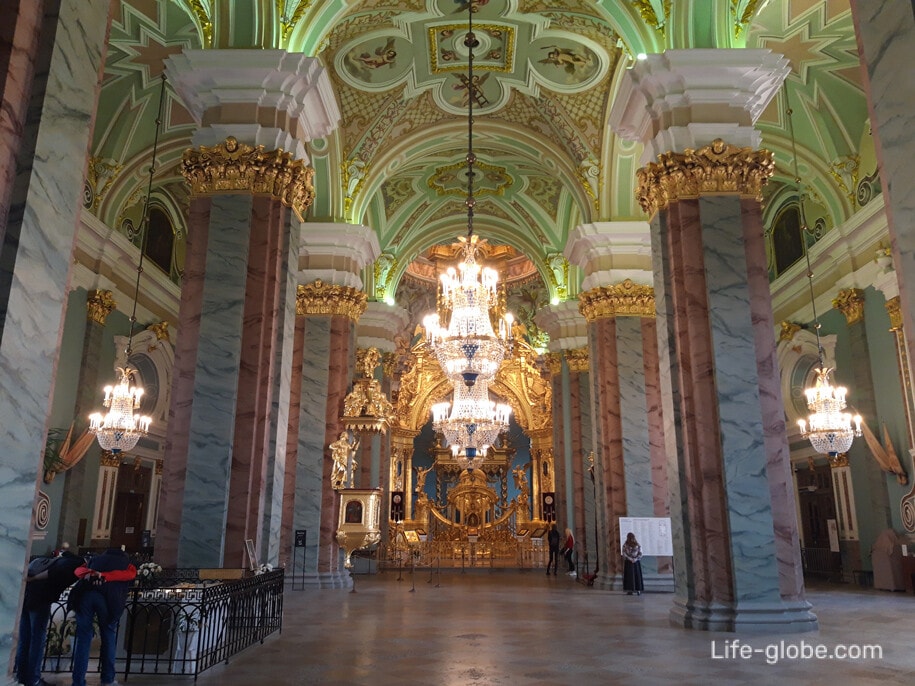

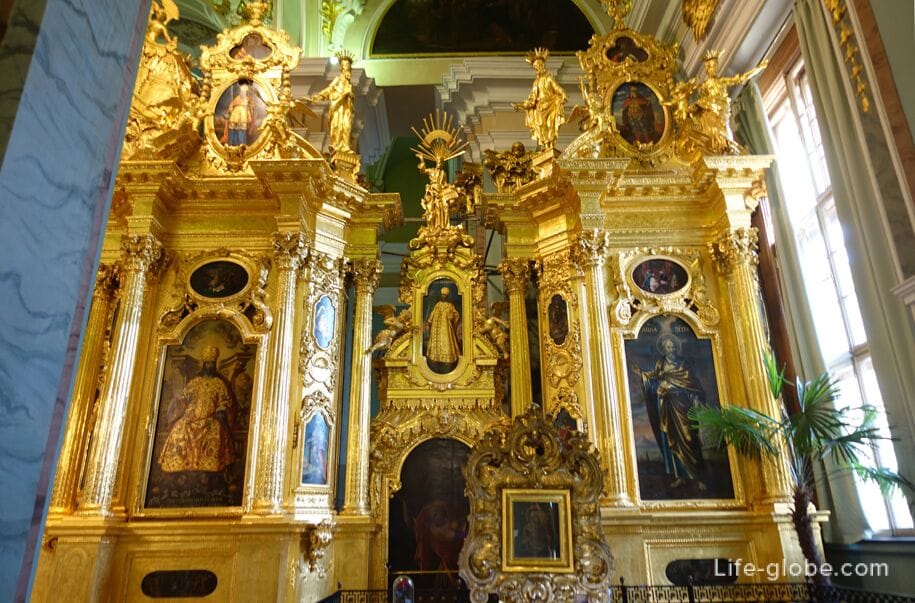
The royal gates of the iconostasis resemble a garden gate in Versailles, they do not close, but, on the contrary, open a view of the canopy (ciborium) raised above the throne on four twisted columns, like the canopy of the middle cross Cathedral of St. Peter in the Vatican.
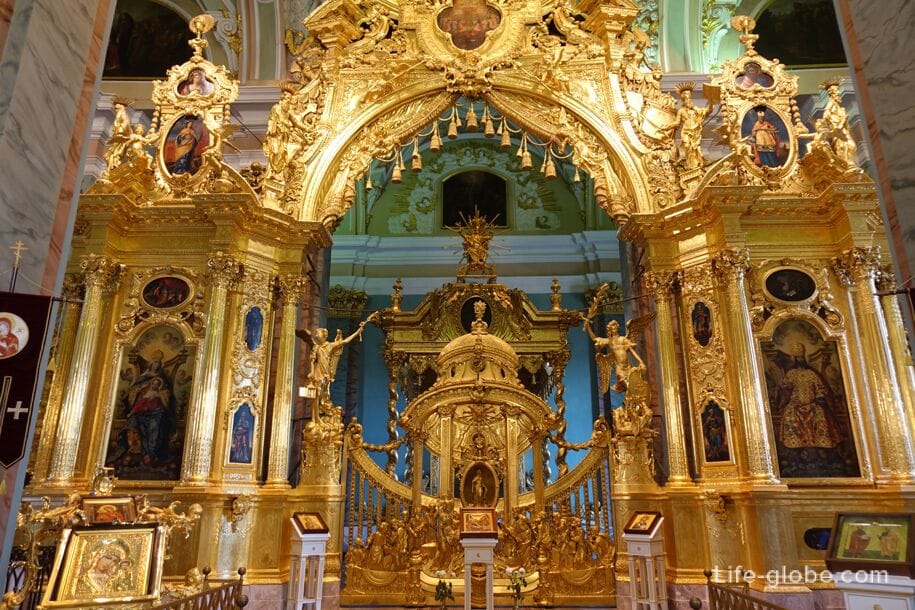
In front of the altar (iconostasis) there is a pulpit for delivering sermons. In the Orthodox churches, the practice of reading sermons was first introduced in the reign of Peter I.
The pulpit was made in 1732 by master Nicholas Kraskop in the forms of the Western European Baroque style.
A spiral staircase leads to the pulpit, decorated with paintings, the theme of which illustrates the biblical saying "In the beginning was the Word".
The canopy above the pulpit is decorated with sculptural images of the apostles Peter and Paul and the four Evangelists. The composition is crowned by a dove with outstretched wings-a symbol of the Holy Spirit and the Divine Word.
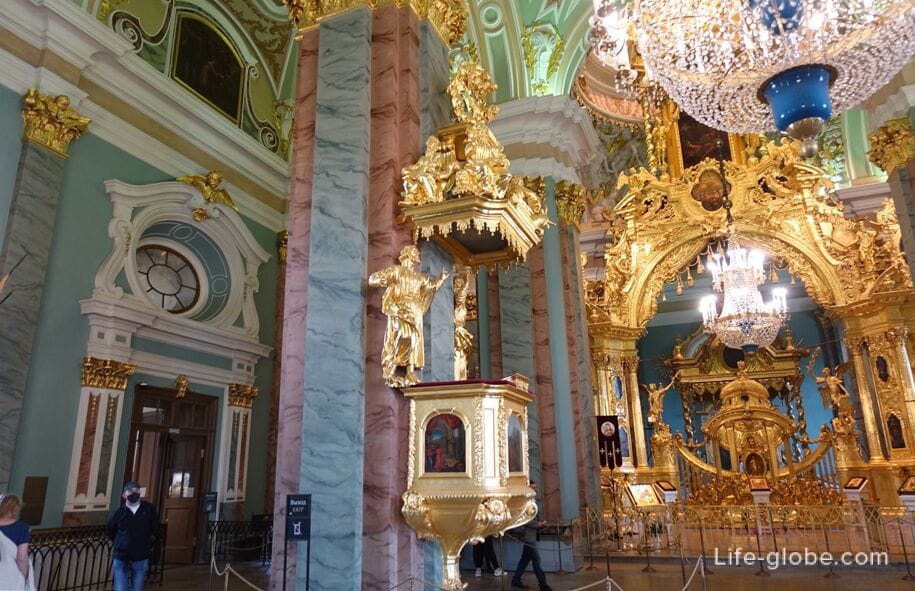
Symmetrical to the pulpit is the royal place-the platform where the emperor stood during the divine service.

Observation deck of the Peter and Paul Cathedral (bell tower of the cathedral)
On the bell tower of the cathedral there are bells, some of which have been preserved since 1757. There is also a carillon installed there.
The carillon on the bell tower is a gift from Flanders (Belgium). This is a contribution to the restoration of musical traditions, whose life in the Peter and Paul Fortress began at the behest of Peter the Great. The instrument has 51 bells and was created under the direction of the Royal Carillon School named after Jef Denein in Mechelen (Malin) with the funds of 352 donors from different countries.
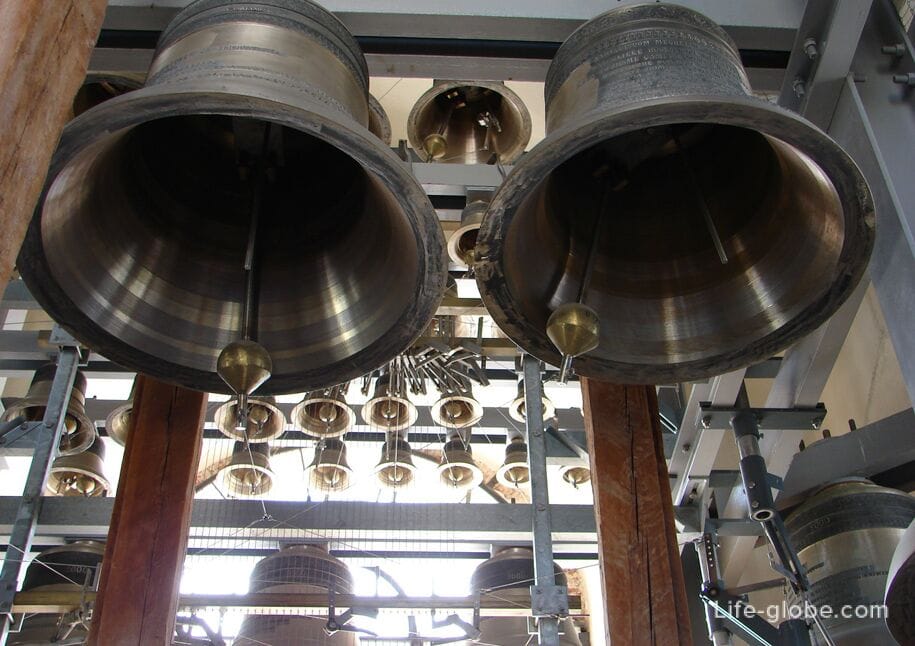
In the bell tower of the cathedral there is an observation deck that you can visit.
The ascent to the observation deck is carried out by a narrow staircase.
The observation deck is paid. A separate entrance ticket is valid.
Grand Ducal Tomb
The cathedral is connected by a covered gallery with the Grand Ducal Tomb, built at the cathedral for the burial of the grand dukes-members of the House of Romanov.
If the crowned representatives of the Russian Imperial House are buried in the cathedral itself, then in the Grand Ducal tomb - persons who had the title of grand dukes and princesses, as well as princes of the imperial blood and members of the Beauharnais family related to the Romanovs, who had the title of Dukes of Leuchtenberg and serene Princes of Romanov.
The Grand Ducal tomb was built in 1896-1906 by architects D. I. Grimm, A. O. Tomishko and L. N. Benau. It is consecrated as the border of the holy noble Grand Duke Alexander Nevsky.
Since 1954, the Grand Ducal Tomb has been part of the museum complex of the history of St. Petersburg.
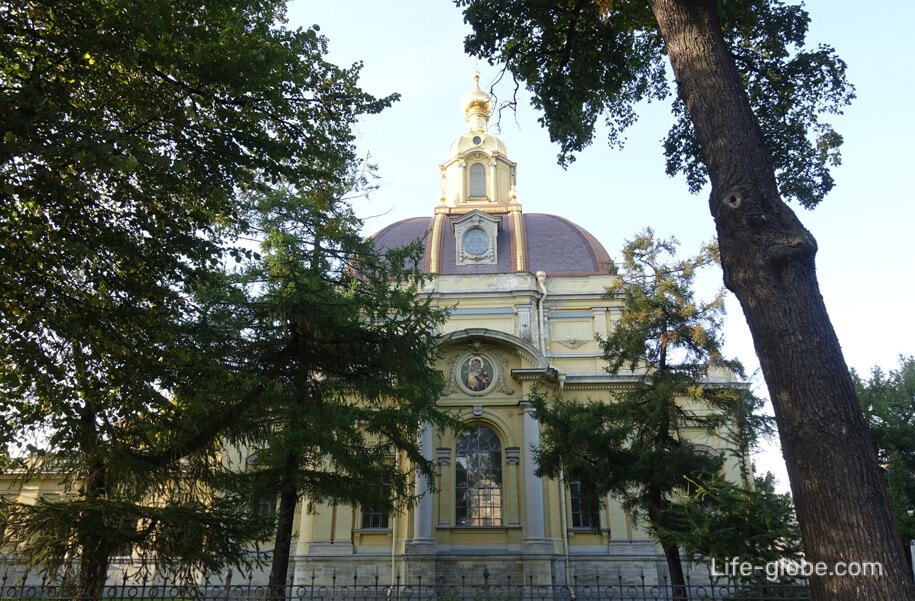
From the Peter and Paul Cathedral to the Grand Ducal tomb leads a covered passage-gallery (corridor), along which are located the former royal waiting rooms.
In 1908-1915, five burials took place in the tomb and eight burials were moved from the Peter and Paul Cathedral.
In 1992, Alexander II's great - grandson, Grand Duke Vladimir Kirillovich, was buried here, and in 1995, the ashes of his parents were transferred from Coburg to the tomb.
Photo of the exit from the cathedral-gallery linking the cathedral and the tomb

Commandant's Cemetery
Near the Grand Ducal tomb and behind the Peter and Paul Cathedral is the Commandant's cemetery - one of the oldest cemeteries in St. Petersburg.
The cemetery contains the ashes of the commandants of the Peter and Paul Fortress, who died at their post.
The first funeral ceremony at the cemetery took place in 1720 in the presence of Peter I - the funeral of a close associate of the tsar - Lieutenant General of the Russian army R. V. Bruce.
The last burial was made in 1914 – the general from the infantry, Adjutant General V. N. Danilov.
The cemetery was damaged during the Great Patriotic War. In the 1960s and 1980s, archaeological excavations were carried out on its territory and the damaged tombstones of the commandants of the 18th century were restored.
The entire cemetery area is planned in three levels, corresponding to the chronology of the graves: the tombstones of the 18th century are located in the center on the lowest level; the graves of the 19th century-on the middle level in the southern part of the cemetery; the graves of the 20th century - on the modern level, in the north-western part of the cemetery.
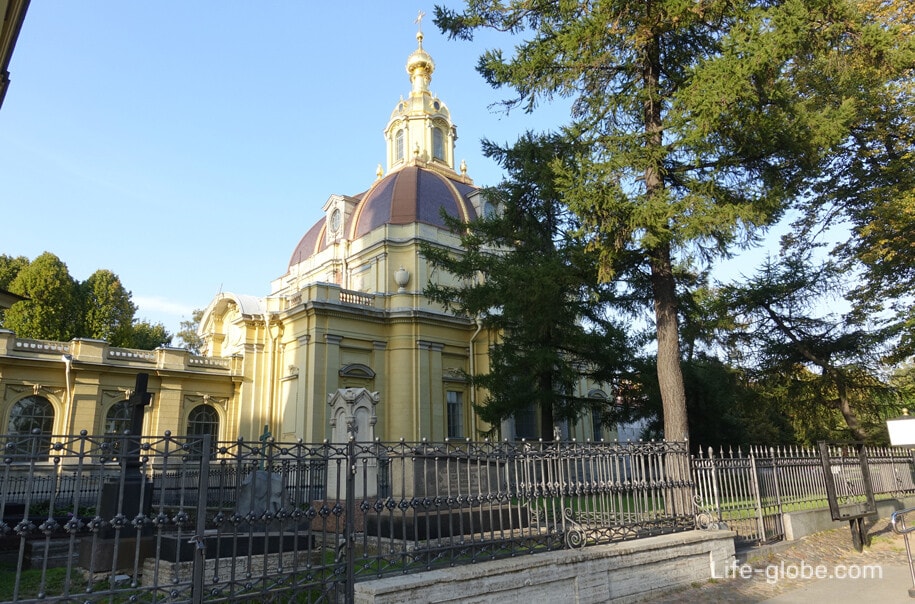
A total of 19 burials are located on the territory of the cemetery.
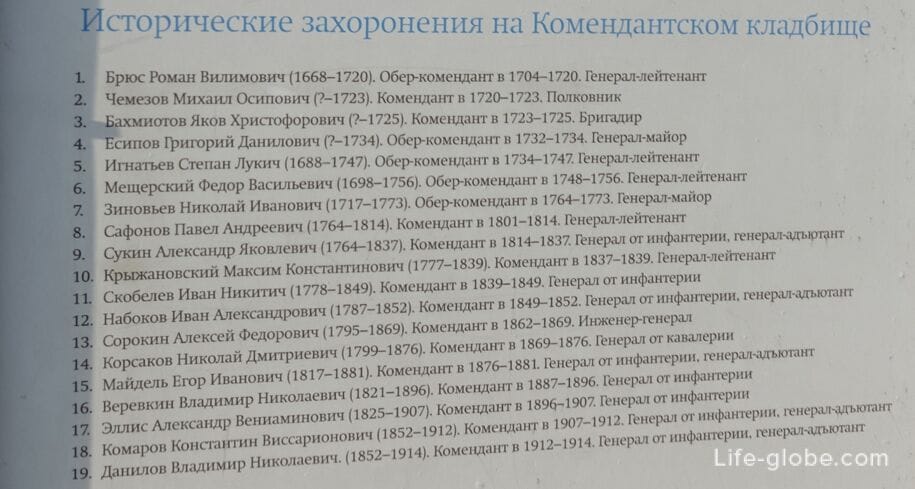
Map of the Peter and Paul Cathedral and the Grand Ducal Tomb
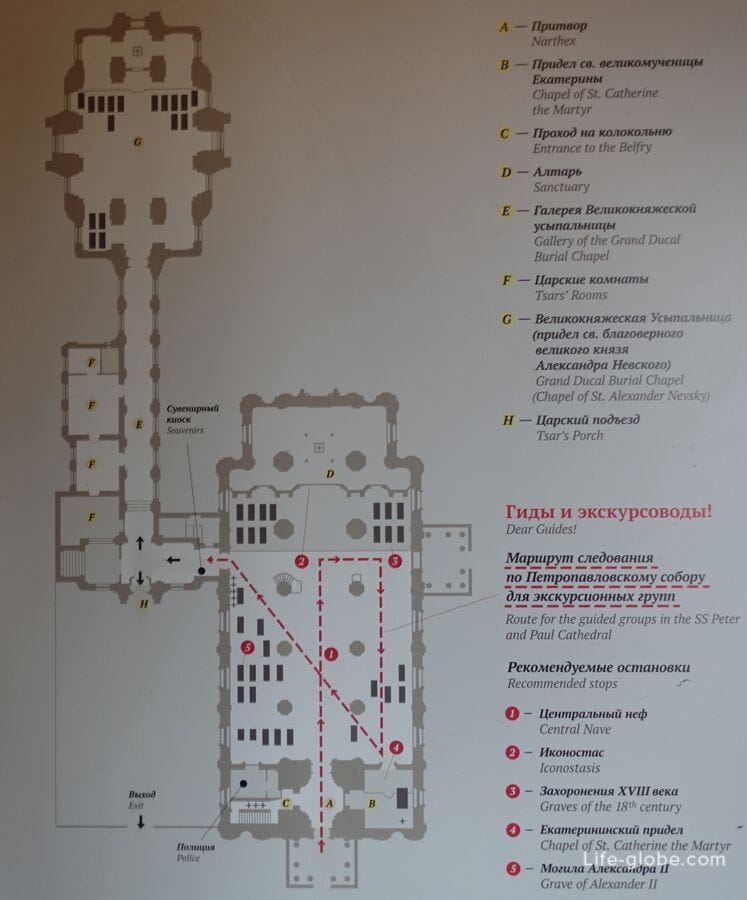
Practical information
The Peter and Paul Cathedral and the Grand Ducal Tomb are now a museum, the entrance to which is paid.
You can buy a separate ticket to the cathedral and the tomb, or a complex ticket, which, in addition to these two objects, will include the opportunity to visit other museums on the territory of the Peter and Paul Fortress.
A visit to the observation deck in the bell tower of the cathedral is also paid. To do this, you must purchase a separate ticket, which is not included in the package or in the ticket to visit the cathedral and the tomb. The ticket for visiting the bell tower is called " Ticket for the excursion route: "Three centuries above the city" with a visit to the Bell Tower of the Peter and Paul Cathedral".
You can visit the cathedral and the tomb, as well as other museums of the fortress all year round.
Visiting the bell tower of the cathedral is possible for sessions at certain times from May 01 to September 30. At other times of the year, only organized groups can visit the bell tower by prior request.
All tickets can be purchased at the museum's ticket offices located directly on the territory of the Peter and Paul Fortress-in Botny house of the Peter and Paul Fortress, located next to the cathedral or in the information center located in the Ioannovsky Ravelin-near St. John's Gate and St. John's Bridge.
The entrance to the territory of the Peter and Paul Fortress itself is free (free of charge). It is necessary to pay, if desired, only for visits to individual objects (museums) of the fortress.
All the necessary information, including the opening hours of the fortress and museums, ticket prices, the location of ticket offices and the conditions for visiting objects on the territory of the fortress, we recommend that you check on the official website of the State Museum of the History of St. Petersburg.
Website of the Museum of the History of St. Petersburg: spbmuseum.
You can also visit the Peter and Paul Fortress with one of the excursions
All accommodation facilities in Saint Petersburg, including in the city center and near the Peter and Paul Fortress, can be viewed and booked here




